Last year, I started hearing about barbershops that would cut young boys’ hair for free if the child read to them while they got their haircut. When I first heard about the program, it brought tears to my eyes because I felt that it is such an invaluable service. In February 2011, NEA released “Focus On: Blacks” which states that 42% of Black students attend under-resourced schools and less than 50% of Black male students graduate on time. These statistics show that there is a dire need to help our Black male youth. The barbershop programs are just one way that communities are working on getting books into young Black boys’ hands to increase literacy rates, and thus, increasing success in lives overall.
In December, my father started working at the Louisiana State University Museum of Art, and he sent me this photo:
And my heart melted! I knew right away that LSU must have a program like what I had heard about. Then, I read a CNN article on March 3rd highlighting a similar program in New York, and I knew that I had to share what LSU is doing in Baton Rouge.
The program in Baton Rouge is called Line 4 Line. It grew out of LSU’s Neighborhood Arts Project, the outreach program of LSU’s Museum of Art, as well as the Art Works Program, a program which focuses on bringing kids from low-performing schools to the art museum. The LSU program is so much more than just a reading program at a barbershop. They have worked to add books and reading to so many different parts of their community, including reading programs during museum tours and Little Libraries.
Lucy Perera, the Coordinator of School & Community Programs at the LSU Museum of Art, told me exactly when the idea formed and how it grew into what it is today. The rest of this post features her words:
I usually incorporate reading in all our museum programs for kids. One month we were making books as our project, and the students were reading after the art portion of the program. One 1st grader was just so happy to be holding a book! He was trying to sound out the words, and he was slowly getting it, and I was helping him and said to him to keep working on it. I asked him if he had books at home, and the answer was no. I asked if he could take books out from your school library, and he said no he couldn’t because he lostt one, and they won’t let him take anymore out. So I gave him the book to take back on the bus (I ride the buses to and from the program just to get to know kids/teachers/school community better), and at the end of the bus ride his teacher grabbed it from him saying, ‘That’s not your book!’ He looked at me, and I was so shocked by the whole ordeal as well not wanting to step on the teachers toes, I let this happen. Each month thereafter, Richard, the student, would always talk to me about that book and give me updates on his reading—I just felt he WANTED to learn but he had so many obstacles—from teachers, to librarian, to family—and this happened again and again with other kids—I saw them being intrigued by the books we had out for them to look at when at the museum, but their reading levels were low, and they just didn’t have them at home.”
The next part of my story involves Neighborhood Arts Project (NAP), a summer program where we always had a reading station with a carpet and rugs and a teen instructor assigned to help the kids or read to them. Then last summer, we received a big donation of books which we gave out, and the kids were so excited! They took so many of them! It was such an amazing gift. They mentioned how they would read them to siblings or start a library in their house, and then some of the older boys shared their struggles with reading and how they were now getting in trouble at school. So I decided we needed to get kids books into their houses because while public libraries are great, they are often not accessible. Also, our bookmobile program has switched over to being a digital bus. And the whole issue of getting a library card requires an ID which many of these parents simply don’t have – let alone cars to get them to a library.
So that is where the free Little Libraries came about. I had one of our LSU students (architecture undergrad) who works with me for NAP design a simple structure, and we worked with a few community partners to build them. Then we had kids from our NAP sites paint them — we place one at a NAP site and the other one ended up at the barber shop.
Line 4 Line came about after reading about the Iowa barber who gave haircut for kids in exchange for reading, and I figured it would be perfect for Baton Rouge. It took me a while to find the right barber. I just kept putting the word out to other Black men about the program and finally found O’Neil Curtis at O’Niel’s Barbershop. He is ideal because he is young and gets the importance of reading as well as the importance of being a good role model to young kids who don’t have a positive male figure encouraging them to read at home. So I met with him, and he was excited.. I placed the library and planted a little garden around it, and we kicked off the program in December. Another local school did a massive book drive which gave us around 4000 books which we have been stocking in libraries and giving out—at a food drive, with a Thanksgiving turkey give away in New Orleans (and for these programs the adults were so happy to get the books for their kids and for themselves).
Line 4 Line takes place once a month, and O’Neil and his other barbers come in and volunteer to cut hair of boys ages 2-13 years for a few hours. I have my helpers who work for NAP assist. We set up books in the barber shop — books from my collection which are either art or Black focused, or classics of all different levels — and kids come in, and I find out their grade, assess their reading level, and help them pick a book. They then read the book to me or one of my helpers with the barber assisting and encouraging while getting hair cut.
For very young readers, we have had younger but strong readers do the reading, or I will work one on one to help them decode and sound out words. As the program is still very new I see lots of ways to adapt, and ways to track progress for repeat kids, and I want to set up an in-house library for all ages in the barbershop and maybe a reading list. There is much to be done to expand this program including book groups or short topics discussions and maybe even mentoring/tutoring — right now we also do art projects with the kids who are waiting for haircuts and at the end of the evening they can go take books home from the Free Little Library.
LINE 4 LINE BACKGROUND
Line 4 Line is a community program of the LSU Museum of Art that works to close the achievement gap and foster positive opportunities for Black youth by providing out-of-school reading, art and mentoring programs.
Line 4 Line strengthens community from within through the creation of impactful opportunities that develop literacy and foster positive expression. The program is designed to be easily expanded and replicated.
PROGRAM
LINE 4 LINE is a community-based literacy and arts program that uses barbershops as unconventional learning sites for Black youth. Growing out of the LSU Museum of Art’s Neighborhood Arts Project LINE 4 LINE leverages the cultural and social significance of barbershops in Black communities to help under-served youth identify positively as readers and learners. LINE 4 LINE also creates a safe and dynamic program space that encourages learning, exploration and mentoring for young adults to make them truly literate citizens. The guiding principal of the LINE 4 LINE program is to connect relatable Black men and women to Black youth as positive role models and mentors to encourage, foster and support the concept of lifelong learning.
LINE 4 LINE addresses three important needs of Black youth living in Baton Rouge, Louisiana and serves as a program model to expand into other communities.
- Provides Black boys with opportunities to interact with relatable adult males in positive healthy role model relationships through the Barbershop Program which gives regular free haircuts to boys in exchange for reading a book, and makes free take-home books accessible to the wider community via a Free Little Library. Books used for this monthly program are considered powerful teaching tools and are selected to be culturally relevant, age appropriate, gender responsive. The reading program works with trained teen mentors who along with Barbers engage and assist children in reading, as well as educators who help track progress.
- Establishes in the Barbershop a safe and dynamic creative space for boys to build healthy relationships around reading and experiencing positive relatable adult role models who support reading. Creates additional educational opportunities by including post-haircut hands on art making via the LSU Museum of Art’s Neighborhood Arts Project.
- Gets books into the hands and households of children and parents. Plans to create a barbershop library of books for patrons of all ages and levels that focuses on and celebrates Black writers, culture, history and experience. This library will include an honor system lending library, as well as on-site books and take home bibliographies with easy links to where relevant books are available locally at libraries, and/or on-line.
I cannot wait to see how program expands!
Keep up with the Baton Rouge Neighborhood Arts Project and Line 4 Line on Facebook!
Learn more about the LSU Museum of Art on Facebook!
**Thank you again to Lucy Perera and Daniel Stetson of the LSU Museum of Art!
All photographs taken by Simone Schmidt.**
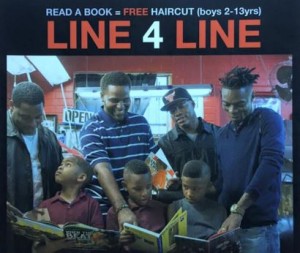
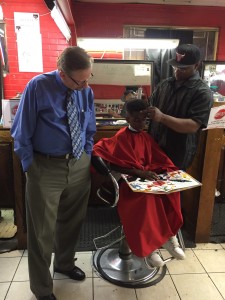
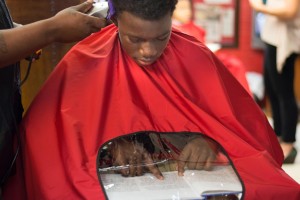
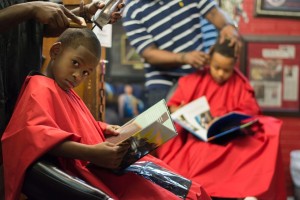
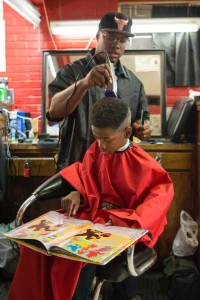
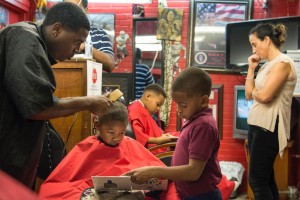
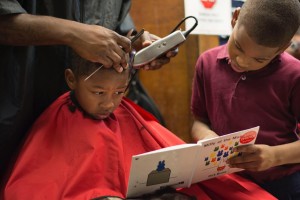
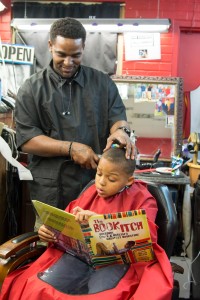
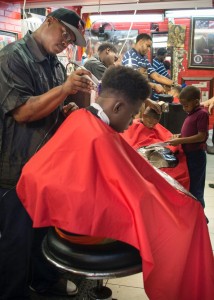

Congratulations! This is a wonderful program, off to a great start!
Wonderful, wonderful program. I hope its influence grows and spreads to other parts of the state.